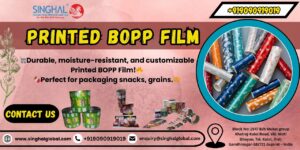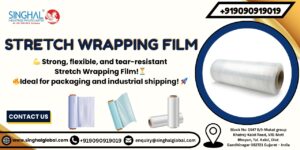Visit any pharmacy and you’ll be greeted with rows of brightly labeled and attractive medicine packs – bottles, sachets, strips, and pouches. Each of them carries something much more valuable than syrups or pills. They are carrying the trust of their customers. In the pharmaceutical industry, trust is the most important thing. The trust that you build is not only by the contents inside, but also by the exterior of the package. That’s why Printed BOPP films come in like unnoticed heroes.
Packaging is usually thought of as a wrapping paper that can be ripped off and thrown away. However, in the world of pharma, packaging can be described as an encasement, a message, as well as legal documents all wrapped up in one. It must safeguard the product, provide precise dosage information, and be professional enough to make patients think twice about the authenticity of the product. That’s a lot for a small piece of plastic. Yet, printed BOPP films in India have been doing it quietly all day long for a long time.
The Essentials of Printed BOPP Films
Printing BOPP (Biaxially Oriented Polypropylene) films are created by stretching polypropylene films in both a transverse and machine direction, which results in better clarity, tensile strength, and barriers. When used in packaging for pharmaceuticals, the films protect sensitive drugs from oxygen, moisture, and environmental pollutants. They are essential for the safety of the patient and effectiveness.
Manufacturing and Market Dynamics in India
India has become an important center for printing BOPP films, catering to international markets with top-quality standards. Famous printed BOPP Films manufacturers in India–like Singhal Industries, Jindal Poly Films Limited Cosmo Films, and Jindal Poly Films Limited–have earned their reputations for reliability, technology development and affordable prices. Ahmedabad and Gujarat specifically are hotspots for production as well as exports, and manufacturers are able to prioritize their customers’ needs and accelerate time-to-market.
Printed BOPP Films Price Insights
The Printed BOPP Films price in India generally ranges between Rs 140 and the equivalent of Rs 160 per kilogram, based on the quality of print as well as thickness and the bulk needs. While the basic films are affordable, more advanced films that have high-resolution printing, UV protection, and special finishes are priced higher. What does this mean? High-end films can reduce the likelihood of product failures and returns. This is a lesson that has been learned by pharmaceutical packagers who initially preferred low-cost alternatives but later regretted the loss of brand stability on shelves and faded logos.
Why Printed BOPP Films Matter in Pharma
Ask any producer, Pharmaceuticals require both cleanliness in addition to shelf impacts. BOPP films can meet both demands. Their clarity and gloss display branding and dosing information clearly while their chemical and moisture resistance protect medications from contamination. for blisters, bags and pouches and strip packaging printed BOPP films effectively stop leaks and secure the contents.
Real-Life Stories of Printed BOPP Films
A packaging manager in Mumbai told of the relief felt when switching to premium BOPP films printed with high-quality printing: “Our tablets stopped discoloring when in transit. Doctors noticed the brand new design immediately. Patients even said that the label was clearer which caused me to smile.” One producer located in Gujarat who threw out cheaper films and ended up in disaster after the package failed tests for humidity. “We learned the hard way: quality costs less in the long run.”
Technical Perks – and Real Contradictions
- Waterproofing: BOPP printed films protect medications from moisture. This is crucial for capsules, tablets, or powder durability. The products can be sealed using heat, securing the products for long distances and sterilized environments.
- Full-Color Printing: The latest flexographic and rotogravure methods allow for vivid multi-color prints, even for intricate designs in pharma.
- Customization: Tailored lengths, widths, and finishes are available for each packaging line.
However, it’s not all perfect. Certain users have complained that poor printing quality due to obsolete ink systems or low-quality substrates can blur crucial information, threatening the compliance of your brand and its reputation. Quality of print should be assessed using scratch resistance and color vibrancy and clarity tests prior to the deployment of mass quantities, a process that is sometimes overly taken lightly in the quest for speed.
Personal Insights and Contradictions
The industry’s obsession with compliance and safety often is in conflict with the need to save money. A manager in Hyderabad said: “We nearly skipped BOPP for a cheaper option, but customer complaints about loose tablets spiked—switching back to premium BOPP saved our reputation.” It’s a bit odd that packaging that’s invisible can be more crucial than the medication itself?
The speed of innovation is awe inspiring. From single-layers to co-extruded, from simple branding, to QR codes-adjusted intelligent packs Printed BOPP Films in india today are not just designed to protect but also interact and educate. Older people worry that the shift to more complex designs detracts from the primary purpose, whereas branding experts say it’s essential for trust and user experience.
Conclusion
Printing BOPP films form the basis of safe, effective packaging for pharmaceuticals. The top manufacturers in India provide international standards for competitive prices, and support an industry in which security as well as communication and brand impact are equally important.
Do you want to improve the quality of your packaging? Investigate top Indian manufacturers – compare price, print quality, and global reach. Since in today’s pharma world choosing the right BOPP film doesn’t just have to be packaging. It’s a sense of security printed on each roll.
Frequently Asked Questions (FAQs)
Q1. Do BOPP printed films become waterproof?
Yes, BOPP films that have been printed are very good at keeping water out hence they may be used in the majority of medical packages.
Q2. Is it possible to print full-color designs on BOPP films?
Absolutely. Modern BOPP film has the ability to print in full color (vibrant) with flexographic and rotational methods thus labeling brands clearly with easily readable dosage instructions.
Q3. Do you use sealed heat films on the BOPP printed films?
Yes, heat can be applied in printing BOPP films to ensure that they are tamper-free and offer integrity of their product throughout transportation and storage.
Q4. What is the procedure of checking the quality of print regarding BOPP film?
Check the films for clarity as well as color accuracy and scratch resistance. Conduct rub tests to ensure that information about the product and regulatory agencies remains clear after exposure and handling.
Q5. Who is the largest exporter of BOPP film?
In India, Jindal Poly Films Limited leads in the global market, having the most extensive BOPP production facility located in Nasik and providing BOPP to more than 40 countries. Cosmo Films and Singhal Industries are among the top exporters, driving the packaging industry in India overseas.









